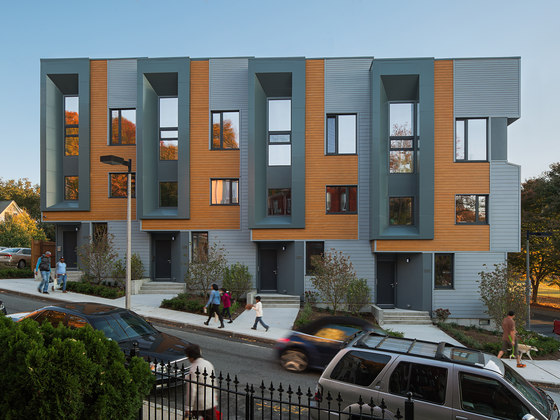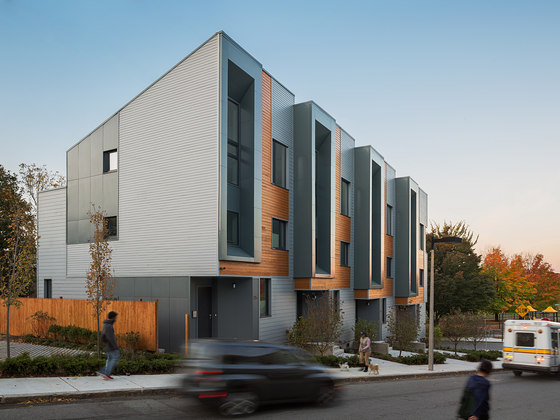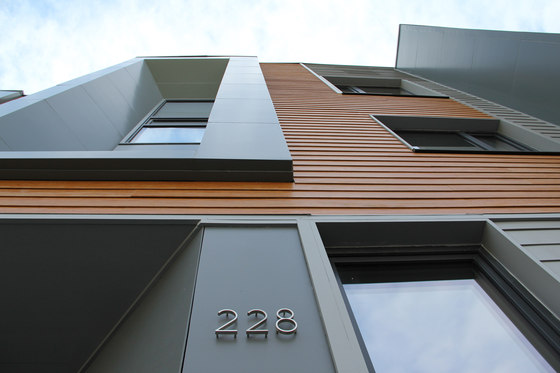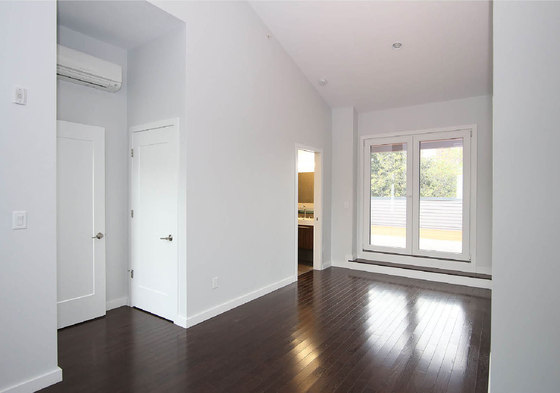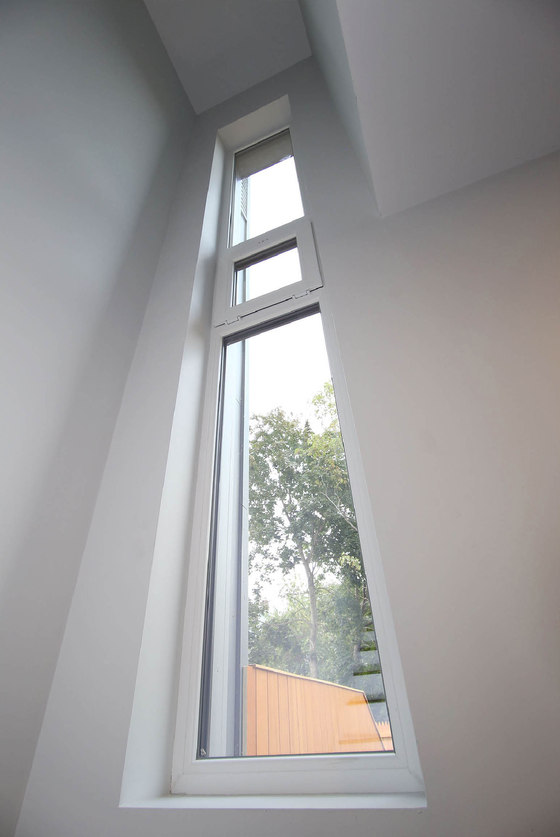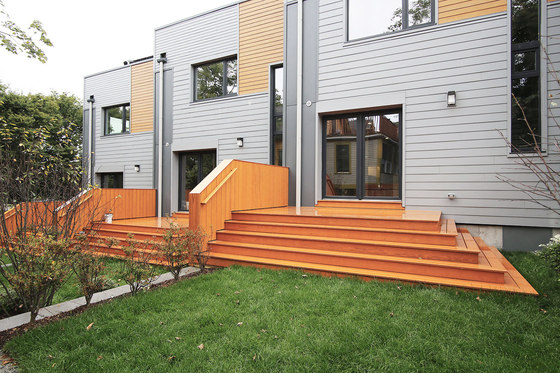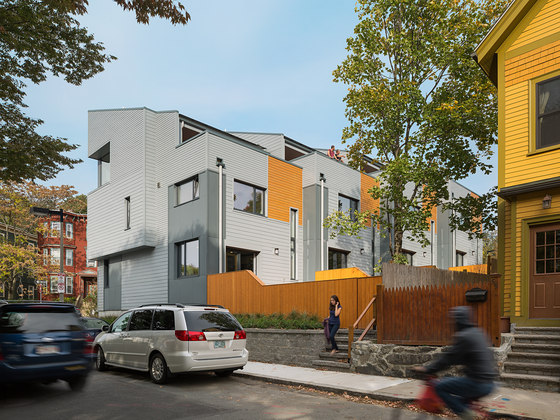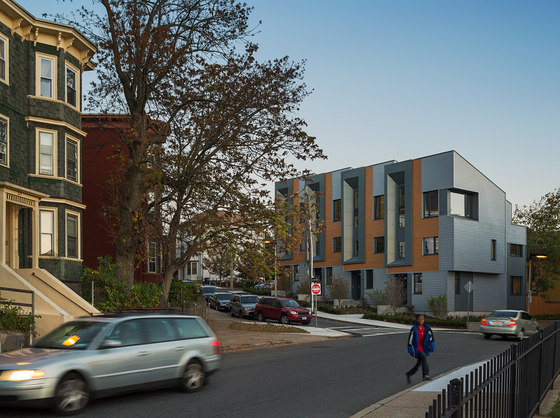E+ // 226 – 232 Highland consists four new three-story wood-frame homes in Roxbury. The project is a part of the City of Boston’s Energy Plus (E+) Green Building Program, a pilot initiative to develop energy positive market rate sustainable housing. The architect and developer were selected through a design competition organized by the Boston Redevelopment Authority for the development of a vacant City Owned parcel in the Roxbury neighborhood.
Site Description
As the site significantly slopes, the homes cascade down the hill to express the unique character of the site and to allow for ideal solar orientation. The massing mediates the corner condition by striking a diagonal setback along the main frontage and opens up the side yard to relate to the park across the street.
Design Concept
The design process began with an elemental box -- simple and affordable to construct, and predictable in its ability to be tightly air sealed and insulated. The box is deformed through three operations: 1) the buildings step down the block in response to the local urban context, 2) the roofs are sloped to maximize solar geometry for photovoltaic panels and 3) a “reverse bay window” at each unit allows for generous natural light, cross ventilation and echoes the playful surface geometries of the context. The lush and verdant landscape design uses native New England plant types that are low maintenance and drought tolerant. Designs for both the architecture and landscape aim to be simultaneously contextual and contemporary.
Green building
The homes are certified LEED Platinum LEED for Homes and have achieved HERS ratings between -6 and -9 (across all four homes). The building envelopes are designed to be thermally robust: double-stud wall construction, high insulation levels, prevention of air infiltration at seams and transitions, and the installation of triple-glazed high performance windows all help to reduce heating and cooling energy use.
The project utilizes high efficiency HRVs (Heat Recovery Ventilator) for air exchange and ductless mini split systems to provide heating and cooling. Hard surface flooring, cleanable walk-off mats and areas to promote shoe removal beside the entryway all seek to create an environment with fewer respiratory irritants than a typical home. Interior finishes include low VOC paints and FSC certified cabinetry. All appliances are Energy Star rated.
Efficient and optimum value engineered framing strategies helped to reduce construction waste during the build process. Low flow toilets, faucets and showerheads and drought tolerant landscaping minimize overall water consumption. Permeable paving and site infiltration strategies also help to put less strain on local municipal water systems.
Renewable energy
The project reduces its environmental impact through a combination of active and passive energy strategies. The design incorporates onsite solar photovoltaic electricity production, natural day lighting, super insulated building envelope, passive ventilation, and site water management tactics.
Each home is equipped with 38 Solar PV panels and a solar thermal panel to provide energy and hot water for the house. The energy output is targeted to exceed the demands of the occupants, with surplus to be sold back to the grid.
Sustainable neighborhood
Roxbury is an eclectic neighborhood with lots of character and charm. We hope our project will contribute to the rich history and social fabric of the neighborhood. The architecture of the project introduces rich patterning through cladding components and formal gestures to create unique textures and visual rhythms. The urban infill location of the site affords great connectivity to mass transportation and amenities in the area.
A comprehensive public awareness program through website, signage, presentation and tours has educated the neighborhood at large on sustainable green building strategies. We hope the project will be a catalyst in helping to educate a new generation of local green collar workers and stimulate the local economy and job opportunities. One of the four approximately 2000 SF +/- townhomes in the project is being offered at 80% AMI, while three of the townhomes will be market rate. The goal is to support the mixed-income nature of the neighborhood while providing housing equity for local residents.
ISA - Interface Studio Architects
Architect of Record: Urbanica Design
Structural Engineer: DM Berg Consultants, PC
Civil Engineer: C.L.G. Associates
MEP / Solar: Engineering Design Build, Inc
Landscape Designer: Urbanica Design
LEED Consultant: Interface Studio Architects, LLC
HERS Rater: Conservation Services Group
Builder: Urbanica Construction
